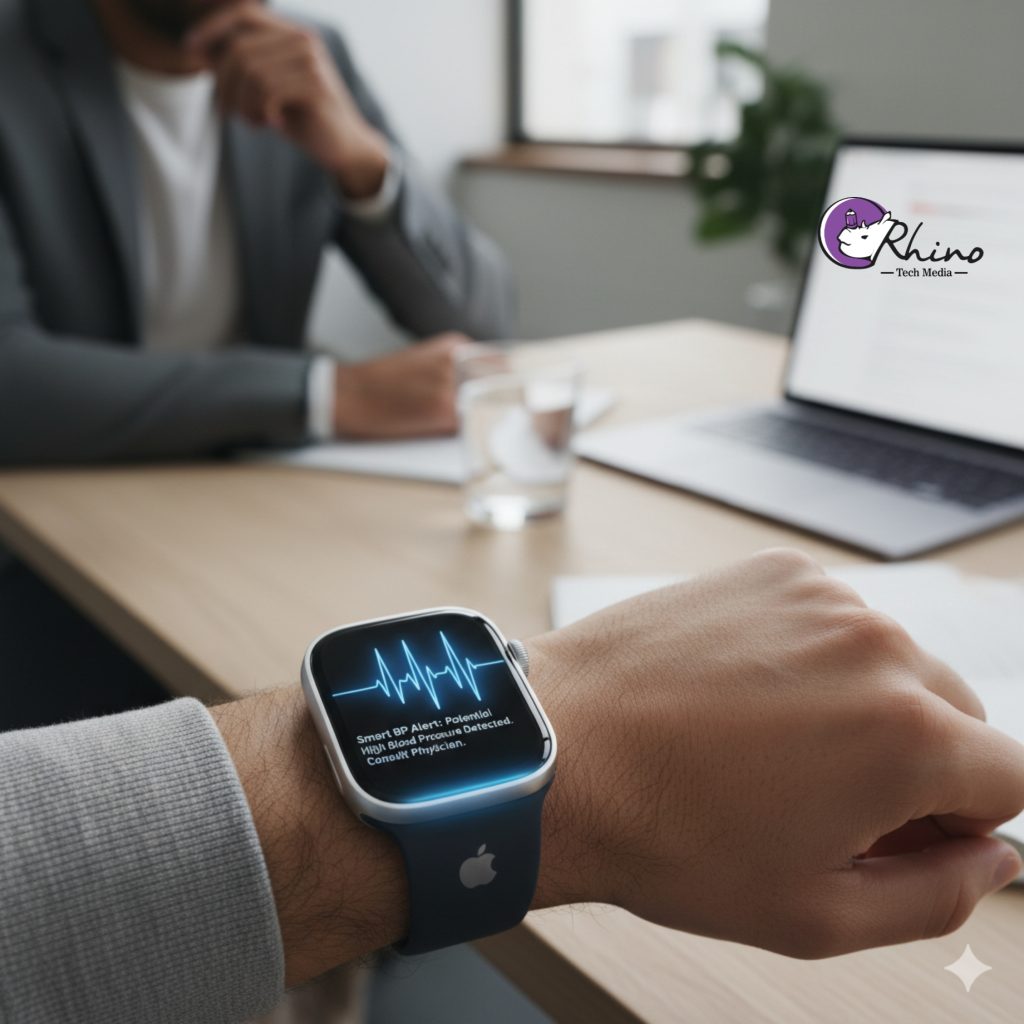Introduction
In September 2025, Apple unveiled a new health-feature for its Apple Watch line: an AI-powered alert system that can notify users of potential high blood pressure. This feature does not replace a traditional blood pressure cuff or monitor, but rather works by analyzing data from sensors already built into the watch to detect patterns associated with hypertension. It was cleared by the U.S. Food and Drug Administration (FDA) and is being rolled out globally via watchOS 26, to models from Series 9 onward.
How It Works
- Sensor Data Collection
Apple Watch uses its existing optical heart sensor (photoplethysmography, or PPG) to monitor how blood vessels respond to each heartbeat. This means detecting changes in blood volume under the skin, which are indirectly related to cardiovascular activity. - Machine Learning / Algorithmic Analysis
- Apple leveraged its long-running Heart and Movement Study (from 2019), which involved ~100,000 participants, to train and discover which features in the optical sensor data correlate best with standard blood pressure measurements.
- The company then validated the resulting algorithm in a separate clinical study with ~2,000 people. This validation is important to assess how well the model performs under real-world conditions.
- Notification Process
- Once the feature is enabled, the watch passively collects data over a 30-day period to establish patterns. Only if consistent signs indicating elevated blood pressure are detected will an alert be sent to the user.
- The user is not given a numerical blood-pressure reading from the watch. Instead, the watch issues a “possible hypertension” notification, and recommends confirmation using a traditional cuff device and/or consulting a healthcare provider.
- Device Compatibility & Rollout
- The feature is available on Apple Watch Series 9 and later, as well as Apple Watch Ultra 2 and later.
- It will roll out via the operating system update (watchOS 26) in over 150 countries.
Strengths and Potential Benefits
- Early Detection
Hypertension is often called a “silent killer” because many people do not realize they have elevated blood pressure until complications arise. The alert system can help identify people who may be at risk earlier than they might otherwise. - Wider Access
Because the feature uses sensors already present in the watch, many users of supported Apple Watch models can benefit, including those who do not have or regularly use a cuff-style monitor. - Regulatory Approval
The FDA clearance gives more credibility to the feature; it indicates that the algorithm has met certain safety and effectiveness thresholds.
Limitations, Challenges, and Risks
- No Direct Blood Pressure Measurement
The watch does not measure blood pressure directly. Without a cuff, its readings are probabilistic / interpretive rather than exact. As a result, the watch can generate false positives (alerts when there is no hypertension), or false negatives (missed cases). - Calibration & Accuracy Variation
Accuracy may vary depending on several factors: skin tone, body type, motion, how the watch is worn, environmental conditions, etc. Because optical sensors are sensitive to how well they can pick up PPG signals, variations in skin perfusion, ambient light, movement, etc., can reduce reliability. - User Expectations / Misinterpretation
Users might mistakenly assume that not getting a notification means they have normal blood pressure, which could lead to false reassurance. Conversely, alerts may trigger anxiety or overuse of healthcare resources. Medical professionals caution that the feature is no substitute for clinical diagnosis. - Regulatory and Guideline Gaps
While Apple has obtained FDA clearance, broader clinical guidelines for cuffless blood pressure monitoring are still underdeveloped. There is limited precedent in recommending cuffless devices in standard hypertension diagnosis workflows.
Implications
- Public Health
If widely adopted, this feature could help reduce undiagnosed hypertension, leading to earlier intervention which might reduce incidence of heart attacks, strokes, kidney disease, etc. It could be especially valuable in populations with limited access to healthcare or where regular checkups are less feasible. - Healthcare System Load
As noted, alerts may increase patient visits or demand for confirmatory tests. Health systems might need to adapt to handle this influx, including ensuring access to validated cuff devices and care providers who can interpret and act on the data. - Wearables & AI in Medicine
This is another step in the direction of non-invasive, continuous health monitoring using AI. It demonstrates growing regulatory acceptance of algorithmic health advisory tools in consumer devices, but also underscores the importance of validation, transparency, and managing trade-offs between convenience and accuracy. - Privacy and Data Use
Because the system depends on collecting and analyzing sensor data over time, issues of user consent, data security, and transparency remain important. Apple has stated that much of the data came from large-scale health studies, and that privacy is built into how they collect and use data.
Conclusion
The AI-powered hypertension alert feature in the new Apple Watch models represents a significant advance in wearable health technology. It offers the promise of earlier detection of high blood pressure by using existing sensors and machine learning techniques — without the user needing to wear a cuff or device that physically measures pressure. However, it is not a replacement for traditional measurement and clinical judgement. Users and providers should view it as a trigger or early warning system rather than a definitive tool. As usage data accumulates, its effectiveness, accuracy, and role in healthcare will become clearer.

